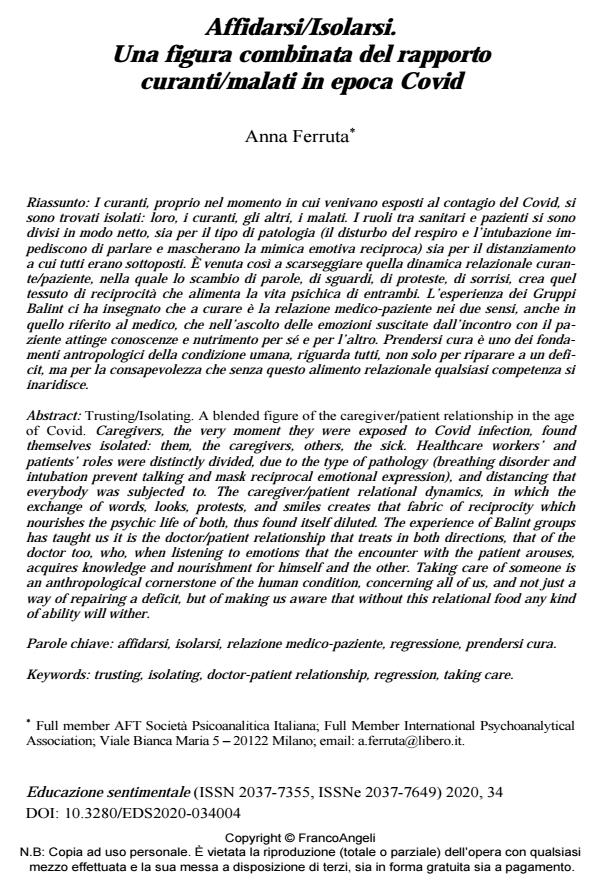Affidarsi/Isolarsi. Una figura combinata del rapporto curanti/malati in epoca Covid
Titolo Rivista EDUCAZIONE SENTIMENTALE
Autori/Curatori Anna Ferruta
Anno di pubblicazione 2021 Fascicolo 2020/34
Lingua Italiano Numero pagine 9 P. 39-47 Dimensione file 246 KB
DOI 10.3280/EDS2020-034004
Il DOI è il codice a barre della proprietà intellettuale: per saperne di più
clicca qui
Qui sotto puoi vedere in anteprima la prima pagina di questo articolo.
Se questo articolo ti interessa, lo puoi acquistare (e scaricare in formato pdf) seguendo le facili indicazioni per acquistare il download credit. Acquista Download Credits per scaricare questo Articolo in formato PDF

FrancoAngeli è membro della Publishers International Linking Association, Inc (PILA)associazione indipendente e non profit per facilitare (attraverso i servizi tecnologici implementati da CrossRef.org) l’accesso degli studiosi ai contenuti digitali nelle pubblicazioni professionali e scientifiche
I curanti, proprio nel momento in cui venivano esposti al contagio del Covid, si sono trovati isolati: loro, i curanti, gli altri, i malati. I ruoli tra sanitari e pazienti si sono divisi in modo netto, sia per il tipo di patologia (il disturbo del respiro e l’intubazione impediscono di parla-re e mascherano la mimica emotiva reciproca) sia per il distanziamento a cui tutti erano sot-toposti. È venuta così a scarseggiare quella dinamica relazionale curante/paziente, nella qua-le lo scambio di parole, di sguardi, di proteste, di sorrisi, crea quel tessuto di reciprocità che alimenta la vita psichica di entrambi. L’esperienza dei Gruppi Balint ci ha insegnato che a curare è la relazione medico-paziente nei due sensi, anche in quello riferito al medico, che nell’ascolto delle emozioni suscitate dall’incontro con il paziente attinge conoscenze e nutri-mento per sé e per l’altro. Prendersi cura è uno dei fondamenti antropologici della condizio-ne umana, riguarda tutti, non solo per riparare a un deficit, ma per la consapevolezza che senza questo alimento relazionale qualsiasi competenza si inaridisce.
Parole chiave:Affidarsi, isolarsi, relazione medico-paziente, regressione, prendersi cura.
Anna Ferruta, Affidarsi/Isolarsi. Una figura combinata del rapporto curanti/malati in epoca Covid in "EDUCAZIONE SENTIMENTALE" 34/2020, pp 39-47, DOI: 10.3280/EDS2020-034004